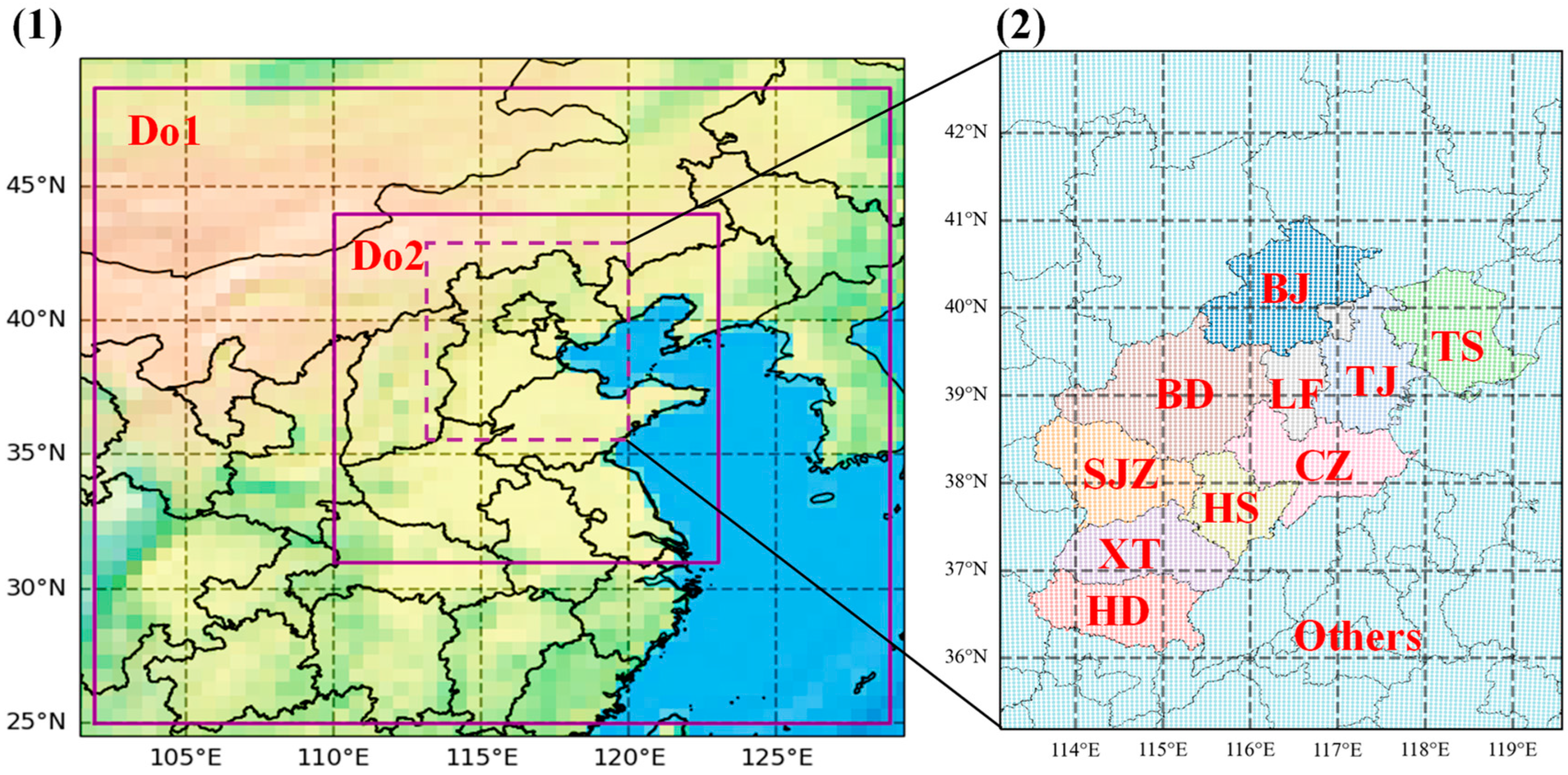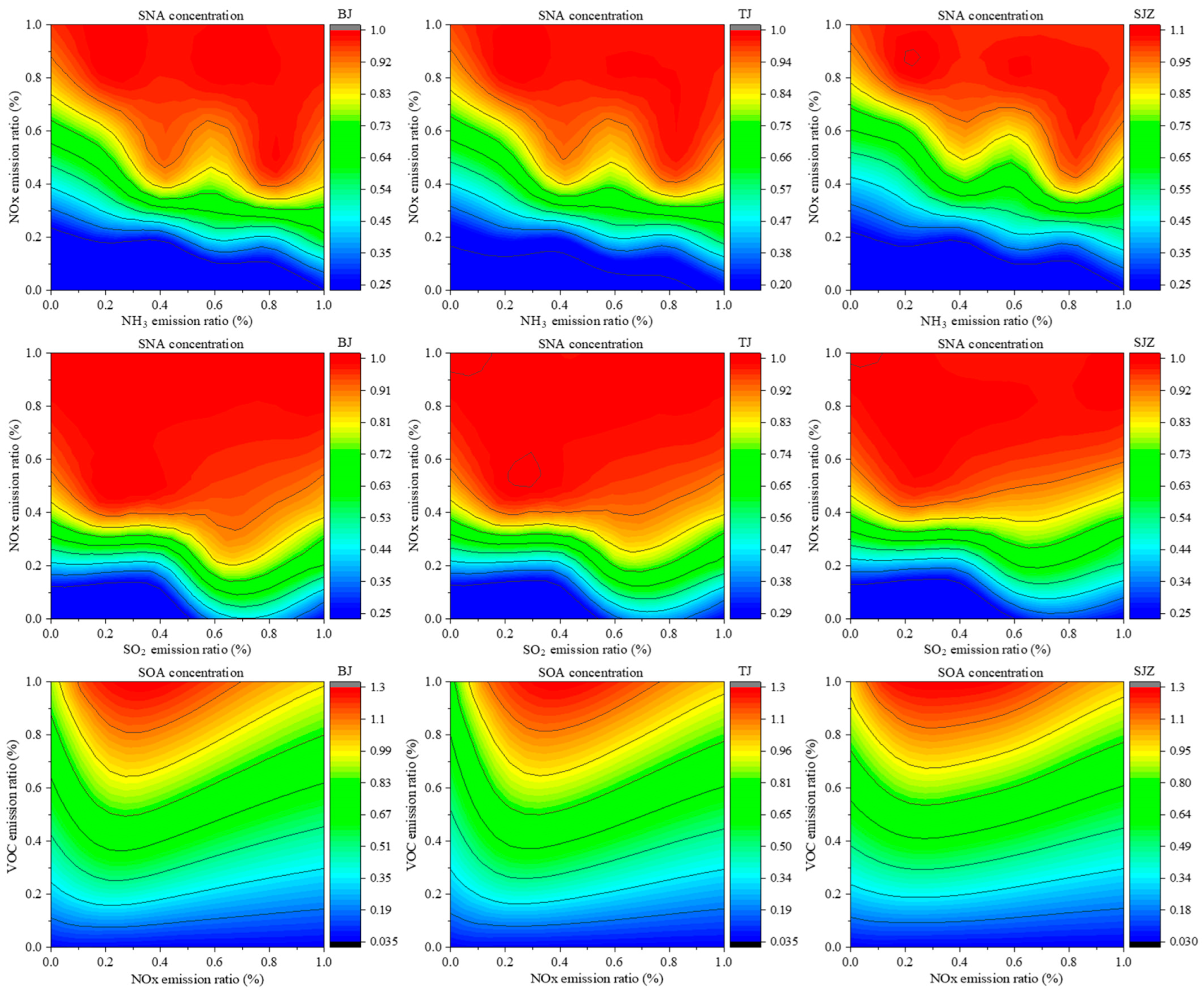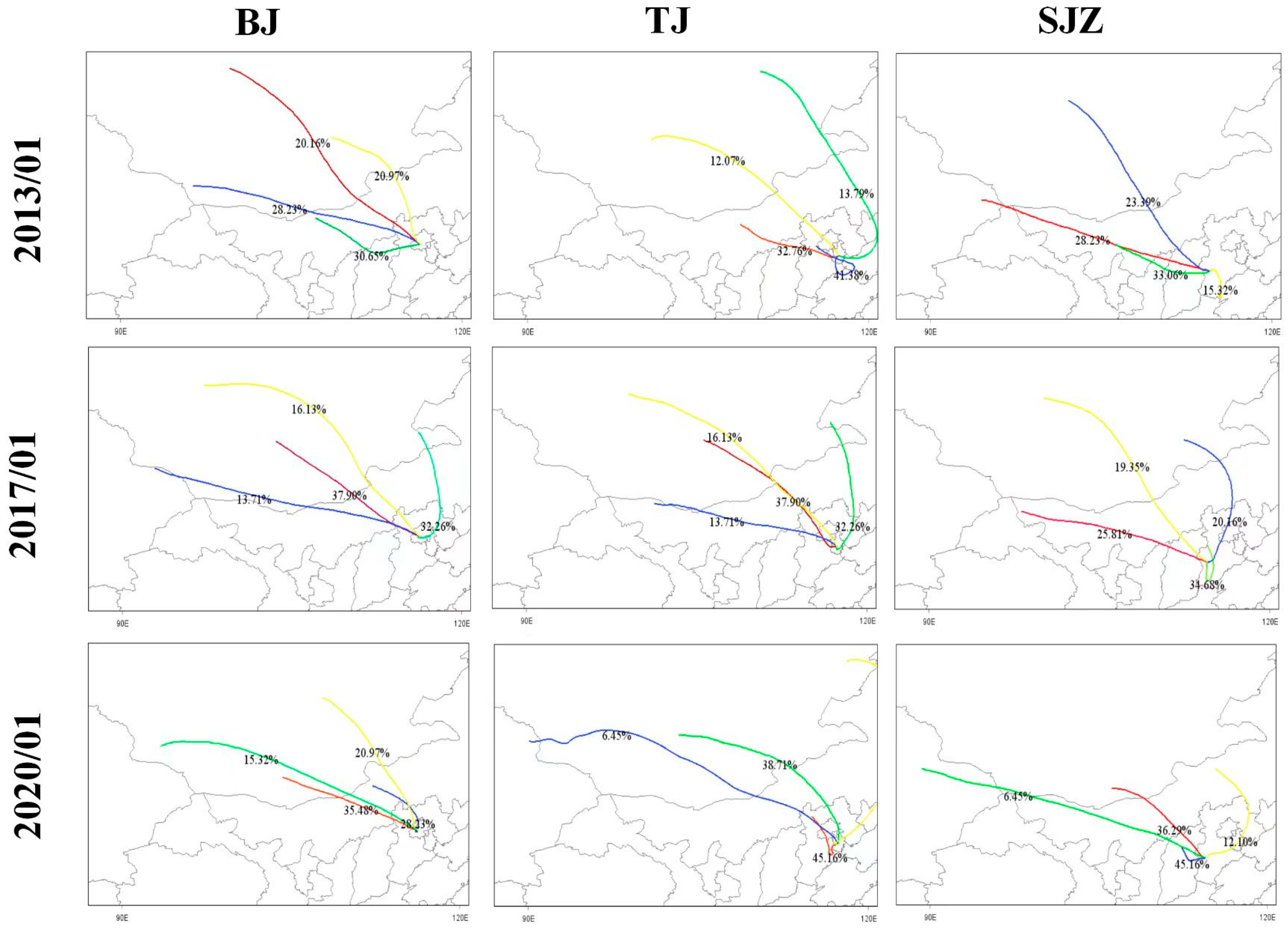Analysis of PM2.5 Transport Characteristics and Continuous Improvement in High-Emission-Load Areas of the Beijing–Tianjin–Hebei Region in Winter
Abstract
1. Introduction
2. Materials and Methods
2.1. Data Source
2.2. Model Configuration
2.3. PM2.5 Flux Calculation
2.4. Model Evaluation
3. Results and Discussion
3.1. The Characteristics of PM2.5 Concentration and Pollutant Emissions
3.2. Characteristics of PM2.5 Transport Flux in the BTH Region
3.3. Regional Sources Apportionment of PM2.5 in the BTH Region
3.4. Scenario Simulation Response Surfaces
3.5. Rationality and Uncertainty Analysis
4. Conclusions
Author Contributions
Funding
Institutional Review Board Statement
Informed Consent Statement
Data Availability Statement
Conflicts of Interest
References
- Chen, H.; Lin, Y.; Chiueh, P. Nexus of ecosystem service-human health-natural resources: The nature-based solutions for urban PM2.5 pollution. Sustain. Cities Soc. 2023, 91, 104441. [Google Scholar] [CrossRef]
- Wang, S.; Gao, J.; Guo, L.; Nie, X.; Xiao, X. Meteorological Influences on Spatiotemporal Variation of PM2.5 Concentrations in Atmospheric Pollution Transmission Channel Cities of the Beijing–Tianjin–Hebei Region, China. Int. J. Environ. Res. Public Health 2022, 19, 1607. [Google Scholar] [CrossRef] [PubMed]
- Qu, K.; Yan, Y.; Wang, X.; Jin, X.; Vrekoussis, M.; Kanakidou, M.; Brasseur, G.P.; Lin, T.; Xiao, T.; Cai, X.; et al. The effect of cross-regional transport on ozone and particulate matter pollution in China: A review of methodology and current knowledge. Sci. Total Environ. 2024, 947, 174196. [Google Scholar] [CrossRef] [PubMed]
- Chang, X.; Wang, S.; Zhao, B.; Cai, S.; Hao, J. Assessment of inter-city transport of particulate matter in the Beijing-Tianjin-Hebei region. Atmos. Chem. Phys. 2018, 18, 4843–4858. [Google Scholar] [CrossRef]
- Wang, G.; Zhu, Z.; Zhao, N.; Wei, P.; Li, G.; Zhang, H. Variations in characteristics and transport pathways of PM2.5 during heavy pollution episodes in 2013–2019 in Jinan, a central city in the north China Plain. Environ. Pollut. 2021, 284, 117450. [Google Scholar] [CrossRef]
- Chang, X.; Wang, S.; Zhao, B.; Xing, J.; Liu, X.; Wei, L.; Song, Y.; Wu, W.; Cai, S.; Zheng, H.; et al. Contributions of inter-city and regional transport to PM2.5 concentrations in the Beijing-Tianjin-Hebei region and its implications on regional joint air pollution control. Sci. Total Environ. 2019, 660, 1191–1200. [Google Scholar] [CrossRef]
- Zhang, X.; Yu, B. Analysis on the Evolution, Causes, and Countermeasures of Urban Haze Components in Beijing. E3S Web Conf. 2023, 369, 1011. [Google Scholar] [CrossRef]
- Xue, Y.; Zhang, S.; Nie, T.; Cao, X.; Shi, A. Environmental Effective Assessment of Control Measures Implemented by Clean Air Action Plan (2013–2017) in Beijing, China. Atmosphere 2020, 11, 189. [Google Scholar] [CrossRef]
- Shu, Y.; Li, H.; Wagner, F.; Zhang, S.; Yang, T.; Klimont, Z.; Kiesewetter, G.; Wang, H.; Sander, R.; Binh, N. Pathways toward PM2.5 air quality attainment and its CO2 mitigation co-benefits in China’s northern cities by 2030. Urban Clim. 2023, 50, 101584. [Google Scholar] [CrossRef]
- Diao, B.; Ding, L.; Cheng, J.; Fang, X. Impact of transboundary PM2.5 pollution on health risks and economic compensation in China. J. Clean. Prod. 2021, 326, 129312. [Google Scholar] [CrossRef]
- Zhao, X.; Zhang, Z.; Xu, J.; Gao, J.; Cheng, S.; Zhao, X.; Xia, X.; Hu, B. Impacts of aerosol direct effects on PM2.5 and O3 respond to the reductions of different primary emissions in Beijing-Tianjin-Hebei and surrounding area. Atmos. Environ. 2023, 309, 119948. [Google Scholar] [CrossRef]
- Jiang, L.; He, S.; Zhou, H. Spatio-temporal characteristics and convergence trends of PM2.5 pollution: A case study of cities of air pollution transmission channel in Beijing-Tianjin-Hebei region, China. J. Clean. Prod. 2020, 256, 120631. [Google Scholar] [CrossRef]
- Mao, K.; Yao, Y.; Wang, K.; Liu, C.; Tang, G.; Feng, S.; Shen, Y.; Ju, A.; Zhou, H.; Li, Z. Analysis of PM2.5 Pollution Transport Characteristics and Potential Sources in Four Chinese Megacities During 2022: Seasonal Variations. Atmosphere 2024, 15, 1482. [Google Scholar] [CrossRef]
- Fang, C.; Qiu, J.; Li, J.; Wang, J. Analysis of the meteorological impact on PM2.5 pollution in Changchun based on KZ filter and WRF-CMAQ. Atmos. Environ. 2022, 271, 118924. [Google Scholar] [CrossRef]
- Shu, L.; Wang, T.; Liu, J.; Chen, Z.; Wu, H.; Qu, Y.; Li, M.; Xie, M. Elucidating drivers of severe wintertime fine particulate matter pollution episodes in the Yangtze River Delta region of eastern China. Sci. Total Environ. 2024, 912, 169546. [Google Scholar] [CrossRef]
- De Angelis, E.; Carnevale, C.; Turrini, E.; Volta, M. Source Apportionment and Integrated Assessment Modelling for Air Quality Planning. Electronics 2020, 9, 1098. [Google Scholar] [CrossRef]
- Zhang, Y.; Chen, X.; Yu, S.; Wang, L.; Li, C.; Li, M.; Liu, W.; Li, P.; Rosenfeld, D.; Seinfeld, J.H. City-level air quality improvement in the Beijing-Tianjin-Hebei region from 2016/17 to 2017/18 heating seasons: Attributions and process analysis. Environ. Pollut. 2021, 274, 116523. [Google Scholar] [CrossRef]
- Zheng, G.J.; Duan, F.K.; Su, H.; Ma, Y.L.; Cheng, Y.; Zheng, B.; Zhang, Q.; Huang, T.; Kimoto, T.; Chang, D.; et al. Exploring the severe winter haze in Beijing: The impact of synoptic weather, regional transport and heterogeneous reactions. Atmos. Chem. Phys. 2015, 15, 2969–2983. [Google Scholar] [CrossRef]
- Miao, Y.; Guo, J.; Liu, S.; Wei, W.; Zhang, G.; Lin, Y.; Zhai, P. The Climatology of Low-Level Jet in Beijing and Guangzhou, China. J. Geophys. Res. Atmos. 2018, 123, 2816–2830. [Google Scholar] [CrossRef]
- Hua, Y.; Wang, S.; Wang, J.; Jiang, J.; Zhang, T.; Song, Y.; Kang, L.; Zhou, W.; Cai, R.; Wu, D.; et al. Investigating the impact of regional transport on PM2.5 formation using vertical observation during APEC 2014 Summit in Beijing. Atmos. Chem. Phys. 2016, 16, 15451–15460. [Google Scholar] [CrossRef]
- Zhen, J.; Guan, P.; Yang, R.; Zhai, M. Transport matrix of PM2.5 in Beijing-Tianjin-Hebei and Yangtze River Delta regions: Assessing the contributions from emission reduction and meteorological conditions. Atmos. Environ. 2023, 304, 119775. [Google Scholar] [CrossRef]
- Zhang, X.; Yuan, C.; Zhuang, Z. Exploring the change in PM2.5 and ozone concentrations caused by aerosol–radiation interactions and aerosol–cloud interactions and the relationship with meteorological factors. Atmosphere 2021, 12, 1585. [Google Scholar] [CrossRef]
- Tao, H.; Xing, J.; Zhou, H.; Pleim, J.; Ran, L.; Chang, X.; Wang, S.; Chen, F.; Zheng, H.; Li, J. Impacts of improved modeling resolution on the simulation of meteorology, air quality, and human exposure to PM2.5, O3 in Beijing, China. J. Clean. Prod. 2020, 243, 118574. [Google Scholar] [CrossRef]
- Zhang, W.; Hai, S.; Zhao, Y.; Sheng, L.; Zhou, Y.; Wang, W.; Li, W. Numerical modeling of regional transport of PM2.5 during a severe pollution event in the Beijing-Tianjin-Hebei region in November 2015. Atmos. Environ. 2021, 254, 118393. [Google Scholar] [CrossRef]
- Xu, H.; Chen, H. Impact of urban morphology on the spatial and temporal distribution of PM2.5 concentration: A numerical simulation with WRF/CMAQ model in Wuhan, China. J. Environ. Manage. 2021, 290, 112427. [Google Scholar] [CrossRef]
- Zaman, T.; Juliano, T.; Hawbecker, P.; Astitha, M. On predicting offshore hub height wind speed and wind power density in the northeast US coast using high-resolution WRF model configurations during anticyclones coinciding with wind drought. Energies 2024, 17, 2618. [Google Scholar] [CrossRef]
- Li, W.; Wang, Y.; Liu, X.; Soleimanian, E.; Griggs, T.; Flynn, J.; Walter, P. Understanding offshore high-ozone events during TRACER-AQ 2021 in Houston: Insights from WRF-CAMx photochemical modeling. Atmos. Chem. Phys. 2023, 23, 13685–13699. [Google Scholar] [CrossRef]
- Kadaverugu, R.; Matli, C.; Biniwale, R. Suitability of WRF model for simulating meteorological variables in rural, semi-urban and urban environments of Central India. Meteorol. Atmos. Phys. 2021, 133, 1379–1393. [Google Scholar] [CrossRef]
- Yao, S.; Zhang, H.; Wang, Q. Vertical Distribution of PM2.5 Transport Flux in Summer and Autumn in Beijing. Aerosol Air Qual. Res. 2022, 22, 220143. [Google Scholar] [CrossRef]
- Wang, R.; Wang, X.; Cheng, S.; Zhu, J.; Zhang, X.; Cheng, L.; Wang, K. Determining an optimal control strategy for anthropogenic VOC emissions in China based on source emissions and reactivity. J. Environ. Sci. 2024, 136, 248–260. [Google Scholar] [CrossRef]
- Zhang, J.; Duan, W.; Cheng, S.; Wang, C. A high-resolution (0.1° × 0.1°) emission inventory for the catering industry based on VOCs and PM2.5 emission characteristics of Chinese multi-cuisines. Atmos. Environ. 2024, 319, 120314. [Google Scholar] [CrossRef]
- Cheng, L.; Wei, W.; Zhang, C.; Xu, X.; Sha, K.; Meng, Q.; Jiang, Y.; Cheng, S. Quantitation study on VOC emissions and their reduction potential for coking industry in China: Based on in-situ measurements on treated and untreated plants. Sci. Total Environ. 2022, 836, 155466. [Google Scholar] [CrossRef] [PubMed]
- Lv, L.; Chen, Y.; Han, Y.; Cui, M.; Wei, P.; Zheng, M.; Hu, J. High-time-resolution PM2.5 source apportionment based on multi-model with organic tracers in Beijing during haze episodes. Sci. Total Environ. 2021, 772, 144766. [Google Scholar] [CrossRef] [PubMed]
- Chen, T.; Chang, K.; Tsai, C. Modeling approach for emissions reduction of primary PM2.5 and secondary PM2.5 precursors to achieve the air quality target. Atmos. Res. 2017, 192, 11–18. [Google Scholar] [CrossRef]
- Zhang, Q.; Xue, D.; Liu, X.; Gong, X.; Gao, H. Process analysis of PM2.5 pollution events in a coastal city of China using CMAQ. J. Environ. Sci. 2019, 79, 225–238. [Google Scholar] [CrossRef]
- Lv, L.; Wei, P.; Hu, J.; Chen, Y.; Shi, Y. Source apportionment and regional transport of PM2.5 during haze episodes in Beijing combined with multiple models. Atmos. Res. 2022, 266, 105957. [Google Scholar] [CrossRef]
- Wen, W.; Guo, C.; Ma, X.; Zhao, X.; Liu, L.; Chen, D.; Xu, J. Impact of emission reduction on aerosol-radiation interaction during heavy pollution periods over Beijing-Tianjin-Hebei region in China. J. Environ. Sci. 2020, 95, 2–13. [Google Scholar] [CrossRef]
- Zhai, H.; Huang, L.; Emery, C.; Zhang, X.; Wang, Y.; Yarwood, G.; Fu, J.S.; Li, L. Recommendations on benchmarks for photochemical air quality model applications in China—NO2, SO2, CO and PM10. Atmos. Environ. 2024, 319, 120290. [Google Scholar] [CrossRef]
- Emery, C.; Liu, Z.; Russell, A.G.; Odman, M.T.; Yarwood, G.; Kumar, N. Recommendations on statistics and benchmarks to assess photochemical model performance. J. Air Waste Manag. Assoc. 2017, 67, 582–598. [Google Scholar] [CrossRef]
- Boylan, J.W.; Russell, A.G. PM and light extinction model performance metrics, goals, and criteria for three-dimensional air quality models. Atmos. Environ. 2006, 40, 4946–4959. [Google Scholar] [CrossRef]
- Zhou, D.; Zhong, Z.; Chen, L.; Gao, W.; Wang, M. Can the Joint Regional Air Pollution Control Policy Achieve a Win-Win Outcome for the Environment and Economy? Evidence from China. Econ. Anal. Policy 2022, 74, 13–33. [Google Scholar] [CrossRef]
- Yang, X.; Yang, X.; Zhu, J.; Jiang, P.; Lin, H.; Cai, Z.; Huang, H.; Long, J. Synergic Emissions Reduction Effect of China’s “Air Pollution Prevention and Control Action Plan”: Benefits and Efficiency. Sci. Total Environ. 2022, 847, 157564. [Google Scholar] [CrossRef] [PubMed]
- Xu, M.; Qin, Z.; Zhang, S.; Xie, Y. Health and Economic Benefits of Clean Air Policies in China: A Case Study for Beijing-Tianjin-Hebei Region. Environ. Pollut. 2021, 285, 117525. [Google Scholar] [CrossRef] [PubMed]
- Wang, J.; Gao, A.; Li, S.; Liu, Y.; Zhao, W.; Wang, P.; Zhang, H. Regional joint PM2.5-O3 control policy benefits further air quality improvement and human health protection in Beijing-Tianjin-Hebei and its surrounding areas. J. Environ. Sci. 2023, 130, 75–84. [Google Scholar] [CrossRef]
- Zhang, H.; Lv, L.; Yao, Z.; Guo, W.; Wang, X.; Shan, W.; Li, X.; Shen, X. Vertical Variations of Ozone Transport Flux at Multiple Altitudes and Identification of Major Transport Direction in the North China Plain. J. Environ. Sci. 2025, 155, 488–500. [Google Scholar] [CrossRef]
- Huang, A.; Cheng, W.; Chu, M.; Wang, G.; Yang, H.; Zhang, L. A Comprehensive Attribution Analysis of PM2.5 in Typical Industrial Cities during the Winter of 2016–2018: Effect of Meteorology and Emission Reduction. Atmos. Res. 2024, 299, 107181. [Google Scholar] [CrossRef]
- Yin, D.; Song, Q.; Guo, Y.; Jiang, Y.; Dong, Z.; Zhao, B.; Wang, S.; Gao, D.; Chang, X.; Zheng, H.; et al. Regional Transport Characteristics of PM2.5 Pollution Events in Beijing during 2018–2021. J. Environ. Sci. 2025, 152, 503–515. [Google Scholar] [CrossRef]
- Azmi, S.; Sharma, M. Global PM2.5 and secondary organic aerosols (SOA) levels with sectorial contribution to anthropogenic and biogenic SOA formation. Chemosphere 2023, 336, 139195. [Google Scholar] [CrossRef]
- Ding, D.; Xing, J.; Wang, S.; Dong, Z.; Zhang, F.; Liu, S.; Hao, J. Optimization of a NOx and VOC cooperative control strategy based on clean air benefits. Environ. Sci. Technol. 2022, 56, 739–749. [Google Scholar] [CrossRef]










| Year | Parameters | City | Obs | Sim | COR | NMB | NME |
|---|---|---|---|---|---|---|---|
| 2013 | PM2.5 (μg/m3) | BJ | 159 | 152 | 0.83 | −0.21 | 0.34 |
| TJ | 155 | 163 | 0.72 | −0.27 | 0.41 | ||
| SJZ | 333 | 320 | 0.81 | −0.19 | 0.29 | ||
| WS10 (m/s) | BJ | 3.2 | 3.5 | 0.76 | 0.21 | 0.36 | |
| TJ | 2.8 | 3.3 | 0.72 | 0.26 | 0.41 | ||
| SJZ | 2.3 | 2.6 | 0.69 | 0.32 | 0.43 | ||
| 2017 | PM2.5 (μg/m3) | BJ | 69 | 64 | 0.90 | −0.16 | 0.32 |
| TJ | 72 | 78 | 0.77 | −0.11 | 0.33 | ||
| SJZ | 130 | 118 | 0.88 | −0.15 | 0.26 | ||
| WS10 (m/s) | BJ | 3.4 | 3.7 | 0.80 | 0.19 | 0.35 | |
| TJ | 3.6 | 4.0 | 0.72 | 0.22 | 0.31 | ||
| SJZ | 2.0 | 2.3 | 0.69 | 0.41 | 0.52 | ||
| 2020 | PM2.5 (μg/m3) | BJ | 61 | 54 | 0.86 | −0.18 | 0.36 |
| TJ | 102 | 109 | 0.75 | −0.13 | 0.38 | ||
| SJZ | 151 | 138 | 0.82 | −0.21 | 0.27 | ||
| WS10 (m/s) | BJ | 3.1 | 3.4 | 0.78 | 0.23 | 0.32 | |
| TJ | 2.8 | 2.9 | 0.74 | 0.28 | 0.37 | ||
| SJZ | 2.1 | 2.5 | 0.71 | 0.36 | 0.45 |
Disclaimer/Publisher’s Note: The statements, opinions and data contained in all publications are solely those of the individual author(s) and contributor(s) and not of MDPI and/or the editor(s). MDPI and/or the editor(s) disclaim responsibility for any injury to people or property resulting from any ideas, methods, instructions or products referred to in the content. |
© 2025 by the authors. Licensee MDPI, Basel, Switzerland. This article is an open access article distributed under the terms and conditions of the Creative Commons Attribution (CC BY) license (https://creativecommons.org/licenses/by/4.0/).
Share and Cite
Qiang, Y.; Wang, C.; Wang, X.; Cheng, S. Analysis of PM2.5 Transport Characteristics and Continuous Improvement in High-Emission-Load Areas of the Beijing–Tianjin–Hebei Region in Winter. Sustainability 2025, 17, 6389. https://doi.org/10.3390/su17146389
Qiang Y, Wang C, Wang X, Cheng S. Analysis of PM2.5 Transport Characteristics and Continuous Improvement in High-Emission-Load Areas of the Beijing–Tianjin–Hebei Region in Winter. Sustainability. 2025; 17(14):6389. https://doi.org/10.3390/su17146389
Chicago/Turabian StyleQiang, Yuyao, Chuanda Wang, Xiaoqi Wang, and Shuiyuan Cheng. 2025. "Analysis of PM2.5 Transport Characteristics and Continuous Improvement in High-Emission-Load Areas of the Beijing–Tianjin–Hebei Region in Winter" Sustainability 17, no. 14: 6389. https://doi.org/10.3390/su17146389
APA StyleQiang, Y., Wang, C., Wang, X., & Cheng, S. (2025). Analysis of PM2.5 Transport Characteristics and Continuous Improvement in High-Emission-Load Areas of the Beijing–Tianjin–Hebei Region in Winter. Sustainability, 17(14), 6389. https://doi.org/10.3390/su17146389






